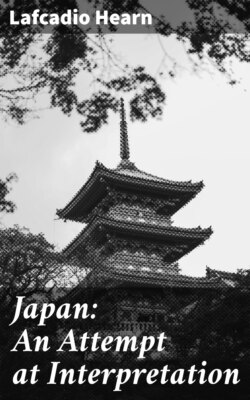Читать книгу Japan: An Attempt at Interpretation - Lafcadio Hearn - Страница 10
На сайте Литреса книга снята с продажи.
DEVELOPMENTS OF SHINTO
ОглавлениеThe teaching of Herbert Spencer that the greater gods of a people—those figuring in popular imagination as creators, or as particularly directing certain elemental forces—represent a later development of ancestor-worship, is generally accepted to-day. Ancestral ghosts, considered as more or less alike in the time when primitive society had not yet developed class distinctions of any important character, subsequently become differentiated, as the society itself differentiates, into greater and lesser. Eventually the worship of some one ancestral spirit, or group of spirits, overshadows that of all the rest; and a supreme deity, or group of supreme deities, becomes evolved. But the differentiations of the ancestor-cult must be understood to proceed in a great variety of directions. Particular ancestors of families engaged in hereditary occupations may develop into tutelar deities presiding over those occupations—patron gods of crafts and guilds. Out of other ancestral cults, through various processes of mental association, may be evolved the worship of deities of strength, of health, of long life, of particular products, of particular localities. [108] When more light shall have been thrown upon the question of Japanese origins, it will probably be found that many of the lesser tutelar or patron gods now worshipped in the country were originally the gods of Chinese or Korean craftsmen; but I think that Japanese mythology, as a whole, will prove to offer few important exceptions to the evolutional law. Indeed, Shinto presents us with a mythological hierarchy of which the development can be satisfactorily explained by that law alone. Besides the Ujigami, there are myriads of superior and of inferior deities. There are the primal deities, of whom only the names are mentioned,—apparitions of the period of chaos; and there are the gods of creation, who gave shape to the land. There are the gods of earth, and, sky, and the gods of the sun and moon. Also there are gods, beyond counting, supposed to preside over all things good or evil in human life,—birth and marriage and death, riches and poverty, strength and disease …. It can scarcely be supposed that all this mythology was developed out of the old ancestor-cult in Japan itself: more probably its evolution began on the Asiatic continent. But the evolution of the national cult—that form of Shinto which became the state religion—seems to have been Japanese, in the strict meaning of the word. This cult is the worship of the gods from whom the emperors claim descent,—the worship of the "imperial ancestors." [109] It appears that the early emperors of Japan—the "heavenly sovereigns," as they are called in the old records—were not emperors at all in the true meaning of the term, and did not even exercise universal authority. They were only the chiefs of the most powerful clan, or Uji, and their special ancestor-cult had probably in that time no dominant influence. But eventually, when the chiefs of this great clan really became supreme rulers of the land, their clan-cult spread everywhere, and overshadowed, without abolishing, all the other cults. Then arose the national mythology.
We therefore see that the course of Japanese ancestor-worship, like that of Aryan ancestor-worship, exhibits those three successive stages of development before mentioned. It may be assumed that on coming from the continent to their present island home, the race brought with them a rude form of ancestor-worship, consisting of little more than rites and sacrifices performed at the graves of the dead. When the land had been portioned out among the various clans, each of which had its own ancestor cult, all the people of the district belonging to any particular clan would eventually adopt the religion of the clan ancestor; and thus arose the thousand cults of the Ujigami. Still later, the special cult of the most powerful clan developed into a national religion,—the worship of the goddess of the sun, [110] from whom the supreme ruler claimed descent. Then, under Chinese influence, the domestic form of ancestor-worship was established in lieu of the primitive family-cult: thereafter offerings and prayers were made regularly in the home, where the ancestral tablets represented the tombs of the family dead. But offerings were still made, on special occasions, at the graves; and the three Shinto forms of the cult, together with later forms of Buddhist introduction, continued to exist; and they rule the life of the nation to-day.
